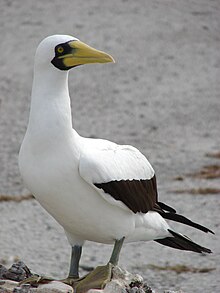| Masked booby | |
|---|---|

| |
| Adult, subsp. personata, Midway Atoll | |
| Scientific classification | |
| Domain: | Eukaryota |
| Kingdom: | Animalia |
| Phylum: | Chordata |
| Class: | Aves |
| Order: | Suliformes |
| Family: | Sulidae |
| Genus: | Sula |
| Species: | S. dactylatra
|
| Binomial name | |
| Sula dactylatra Lesson, 1831
| |
| Subspecies | |
|
See text | |

| |
| Range (in green) | |
The masked booby (Sula dactylatra), also called the masked gannet or the blue-faced booby, is a large seabird of the booby and gannet family, Sulidae. First described by the French naturalist René-Primevère Lesson in 1831, the masked booby is one of six species of booby in the genus Sula. It has a typical sulid body shape, with a long pointed yellowish bill, long neck, aerodynamic body, long slender wings and pointed tail. The adult is bright white with black wings, a black tail and a dark face mask; at 75–85 cm (30–33 in) long, it is the largest species of booby. The sexes have similar plumage. This species ranges across tropical oceans, except in the eastern Atlantic and eastern Pacific. In the latter, it is replaced by the Nazca booby (Sula granti), which was formerly regarded as a subspecies of masked booby.
Nesting takes place in colonies, generally on islands and atolls far from the mainland and close to deep water required for foraging. Territorial when breeding, the masked booby performs agonistic displays to defend its nest. Potential and mated pairs engage in courtship and greeting displays. The female lays two chalky white eggs in a shallow depression on flat ground away from vegetation. The chicks are born featherless, but are soon covered in white down. The second chick born generally does not survive and is killed by its elder sibling. These birds are spectacular plunge divers, plunging into the ocean at high speed in search of prey—mainly flying fish. The species faces few threats; although its population is declining, it is considered to be a least-concern species by the International Union for Conservation of Nature (IUCN).
- ^ BirdLife International (2018). "Sula dactylatra". IUCN Red List of Threatened Species. 2018: e.T22736173A132666363. doi:10.2305/IUCN.UK.2018-2.RLTS.T22736173A132666363.en. Retrieved 12 November 2021.
